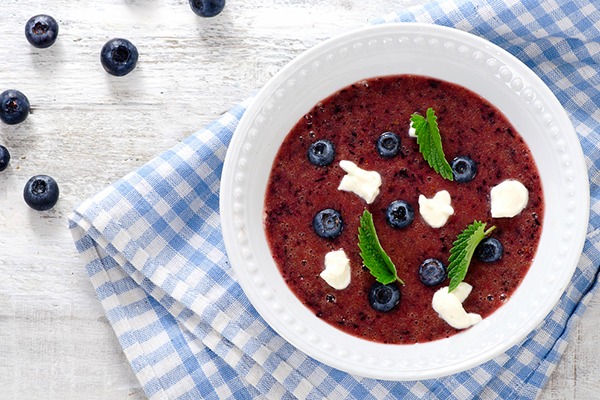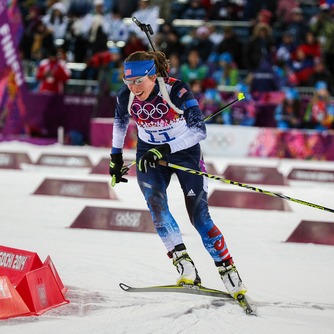
As an Olympian committed to competing clean, I follow a few simple guidelines when choosing my foods so I can fuel my body with food first, rather than supplements.
Fueling Basics
Biathlon is an endurance sport and I burn through a lot of energy, so the first step is simply making sure I eat enough calories. I work with a sports dietician to identify the right balance of carbohydrates, proteins, and fats.
The next step is making sure I get enough micronutrients – these are vitamins and minerals like calcium, vitamin C, vitamin B12, iron, magnesium, etc. Deficiencies in any of these micronutrients can lead to health problems and reduce my athletic performance. Plants have tons of micronutrients and different colored plants often have different types of micronutrients, so my rule of thumb is to include a variety of colorful fruits, vegetables, and other plants in my diet.
 My other key rule is to limit processed foods. Processed foods often contain artificial ingredients, as well as surprisingly high amounts of added sugar, salt, and trans fats. They are also high in calories but missing many essential vitamins and minerals. By including lots of fresh produce in my diet and limiting processed foods, I get most necessary vitamins and minerals directly through my food.
My other key rule is to limit processed foods. Processed foods often contain artificial ingredients, as well as surprisingly high amounts of added sugar, salt, and trans fats. They are also high in calories but missing many essential vitamins and minerals. By including lots of fresh produce in my diet and limiting processed foods, I get most necessary vitamins and minerals directly through my food.
However, as a female athlete, I am prone to iron loss, and as winter sport athlete, I spend a lot of time in dark northern climates, which results in lower vitamin D production. Even when I pay close attention to my diet to maximize nutrient intake, my blood work sometimes shows iron and vitamin D deficiencies. In cases like this, it makes sense to work with a doctor and a dietician and consider a supplement solution.
Fueling Source
When working toward a food-first approach to fueling, I also know that the way food is grown impacts how many nutrients it has. If plants are grown in healthy soil, for example, they will have more nutrients. Whenever possible, I try to eat plants grown in good soil and meat that was raised on quality food so that I get healthy amounts of vitamins and minerals. This also reduces my need to add supplements to my diet.
I became particularly interested in food production early in my biathlon career when I joined the Craftsbury Green Racing Project, an Olympic development team in Vermont that focuses on sustainability. One of my responsibilities as an athlete on that team was to work in the gardens at our sport center and help grow food for its dining hall. That experience opened my eyes to the importance of knowing where food comes from and it gave me an appreciation for using higher quality ingredients.
One of the most challenging times to find high quality foods is when traveling for training or competitions. When traveling through airports or on a long van ride, I find it helpful to bring some go-to snacks from home in case I can’t find good food options during the travel day.
 My sport is primarily based in Europe during the winter and my team eats meals in hotel restaurants. Sometimes we don’t have a lot of choice in the meals we are served, so one of the first things I like to do when I get to a new place is to find the grocery store and stock up on a few key items. Spanish clementines are my absolute favorite winter snack because they are in season, fresh, sweet, and easily available throughout the Alps where I race. I always keep my eye out for specialty foods of the region I’m in. For example, when I’m in Scandinavia, I really enjoy blueberry soup made from forest berries.
My sport is primarily based in Europe during the winter and my team eats meals in hotel restaurants. Sometimes we don’t have a lot of choice in the meals we are served, so one of the first things I like to do when I get to a new place is to find the grocery store and stock up on a few key items. Spanish clementines are my absolute favorite winter snack because they are in season, fresh, sweet, and easily available throughout the Alps where I race. I always keep my eye out for specialty foods of the region I’m in. For example, when I’m in Scandinavia, I really enjoy blueberry soup made from forest berries.
When I’m at home, I have a lot more control over what I can eat. One great source of high-quality food is a farmer’s market. They are a good place to meet the people who grew the food and you can ask them directly about how they care for the health of their soil and livestock. Produce at a farmer’s market will likely be fresher than in many grocery stores because it is more local. Grocery store chains typically stock varieties of produce that have been selected for their ability to keep over thousands of miles of travel rather than for their nutritional value. At farmer’s markets on the other hand, you are more likely to find heirloom varieties that may not keep as well but often have more flavor and more nutrients.
 There’s no better way to get fresh foods than from your own garden…and I love to garden! Vegetables straight from a garden taste incredible and I know exactly how they were produced. I typically grow 20+ different vegetables and fruits. My earliest crops in the spring include asparagus, rhubarb, and sugar snap peas. In the summer, there’s an abundance of cherry tomatoes, cucumbers, and spinach. It’s also nice to have vegetables that store well into the fall, so I grow a lot of potatoes, kale, carrots, red cabbage, beets, and winter squash. Sourcing some of my own protein is very satisfying, so I recently grew pinto beans and black beans, and I’d like to try chickpeas.
There’s no better way to get fresh foods than from your own garden…and I love to garden! Vegetables straight from a garden taste incredible and I know exactly how they were produced. I typically grow 20+ different vegetables and fruits. My earliest crops in the spring include asparagus, rhubarb, and sugar snap peas. In the summer, there’s an abundance of cherry tomatoes, cucumbers, and spinach. It’s also nice to have vegetables that store well into the fall, so I grow a lot of potatoes, kale, carrots, red cabbage, beets, and winter squash. Sourcing some of my own protein is very satisfying, so I recently grew pinto beans and black beans, and I’d like to try chickpeas.
Part of the gardening process is paying attention to the soil health because that affects the nutrient level of the things I grow. Each time you harvest a crop, you are taking nutrients out of that system, so for it to produce nutritious food in future years, you also have to add nutrients back in. That’s why I add compost, fallen leaves, and manure into my garden beds. Over the winter, microorganisms in the ground break these materials down into nutrient-rich dirt that’s full of carbon, nitrogen, and micronutrients.
Why It Matters
If I want to be the best in the world at my sport, I can’t cut corners by using second-rate equipment in a competition. It is just as important to not eat second-rate foods! My body is my most important asset as an athlete. Now I do a little research when I shop for food, I’m willing to budget a little more for high-quality ingredients, and I try to grow some of my food myself.
About Susan Dunklee
 After joining US Biathlon’s development program in 2008 and completing her first World Cup season in 2012, Susan Dunklee went on to become a two-time Olympian by earning a place at the 2014 Sochi Winter Games and at the 2018 PyeongChang Winter Games. Amid that success, she also made waves in 2017 by becoming the first American woman to win a world championship medal in an individual event, taking home a silver in the mass start. In 2020, she also won silver in the sprint and earned recognition as the first U.S. double medalist at the IBU World Championships.
After joining US Biathlon’s development program in 2008 and completing her first World Cup season in 2012, Susan Dunklee went on to become a two-time Olympian by earning a place at the 2014 Sochi Winter Games and at the 2018 PyeongChang Winter Games. Amid that success, she also made waves in 2017 by becoming the first American woman to win a world championship medal in an individual event, taking home a silver in the mass start. In 2020, she also won silver in the sprint and earned recognition as the first U.S. double medalist at the IBU World Championships.
What is food-first nutrition?
Every athlete wants to reach their peak performance, which often means pushing harder and longer in training and in competition. In the quest to reach their maximum potential, many athletes know that good nutrition is critical, but they may also look to the latest supplements and trendy diet regimens to give them that extra boost.
Some athletes, on the other hand, have found that a food-first approach is all they need to achieve peak performance. While some athletes may need to supplement their dietary intake because of a medical condition, many athletes can properly fuel their bodies and meet all their bodies’ needs with the right food.
In the Food-First Nutrition series, Olympians, Paralympians, and elite athletes share how they maintain the strength and energy they need to compete at the highest levels of sport through a food first approach. For more information on the best foods for athletes, check out the TrueSport Nutrition Guide.
Read more Spirit of Sport blog posts



